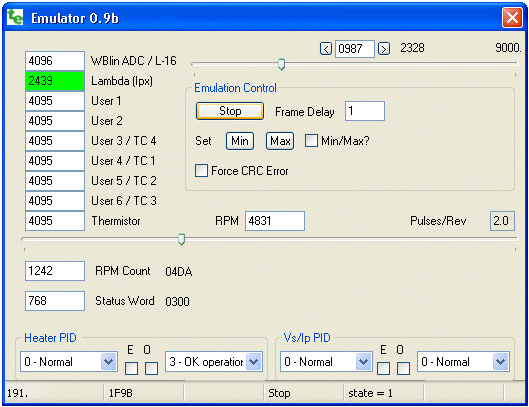WBo2 Emulator - Simulates a Wideband Unit
 The value of each version 2.0 frame variable can be altered by either changing
the value directly, via a slider, or via drop a down menu selection.
As different controllers have different default frame types,
a number of fields can be customised (refer to the drop down menu to the right of some fields).
The value of each version 2.0 frame variable can be altered by either changing
the value directly, via a slider, or via drop a down menu selection.
As different controllers have different default frame types,
a number of fields can be customised (refer to the drop down menu to the right of some fields).
- The top slider varies the quantity currently highlighted in green,
or you can change it by simply typing a new value in.
Change the highlight by clicking on another box - for example, click on the
Lambda (Ipx) box (second down from the top left) to make that the "green box".
Now move the slider and see the hex value (0F1D hex in the image at right) change.
The green Lambda (Ipx) value will also change.
In the image the Lambda (Ipx) value is decimal 3869 (= 0F1D hex).
Note that the maximum allowable value for the slider changes from field to field
and in the image the 2328 hex value and the 9000 decimal (top right) is the maximum value for the Lambda (Ipx)
field. The small left/right arrow buttons increment or decrement the selected value.
The Lambda and AFR values are calculated using the currently selected parameters on the
General tab.
- The middle slider changes the RPM value.
You can also set the RPM by entering a decimal value into the box (7326 shown) above the slider.
To the right, the Pulses/Rev box shows the current value that is set in the
Display section of the General tab.
Depending on Pulses/Rev the RPM Count field (below left of the RPM slider) is converted to a displayed RPM.
And lastly, the hex value of the RPM field ($ 0333 shown) is to the right of the text RPM Count.
- There are two ways to change the Status word (shown as hex value 0300).
Change it in decimal format in the box to the left of the Status Word text - the hex
value shown to the right also changes.
Alternatively, change one of the values in the 4 drop down menu selections and the four check boxes.
A normal status word from a functional wideband controller is 768. (0x0300) and this can
be set by selecting the 3 - OK Operational menu item from the second box.
Various error conditions can be simulated for the Vs/Ip (Lambda control) PID or the Heater PID.
For further info see the status byte details.
The Emulation Control section is only partially implemented as of this software rev, but
pressing the Start toggle button (face then changes to Stop) controls
sending out data frames. Note that when the Stop button is pressed a special Enter Conf Mode
frame is sent as the last frame. This frame forces a display to enter config mode
(the display shows conF). In config mode a display interprets ASCII data as commands in the
same way a wideband unit does, and this mode is used to reprogram the display.
The Force CRC Error check box does just that, forcing each frame to have an incorrect CRC
calculated for it.
The status bar shows the Frame Sequence counter byte field in decimal (191 shown.) and the
Tick word field (1F9B shown) in hex.
Other bar status fields change depending on what controls are being adjusted,
the image shows that the Start button was pressed (changing its text to Stop) and setting the button's state to 1.
To exit the emulator simply close the window (top right X and the currently selected
values will be remembered the next time the emulator is started.
|
 Wideband Software Emulator : Produces data frames just like a real controller.
It is used primarily to test different display configurations and for driving logging software.
It is useful for understanding data frame operation and for developing new hardware (or software) displays.
Wideband Software Emulator : Produces data frames just like a real controller.
It is used primarily to test different display configurations and for driving logging software.
It is useful for understanding data frame operation and for developing new hardware (or software) displays.
 The value of each
The value of each